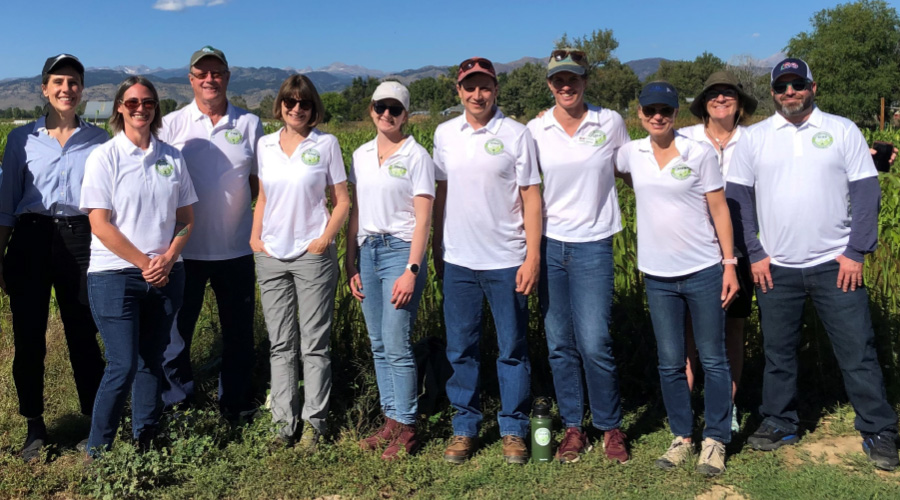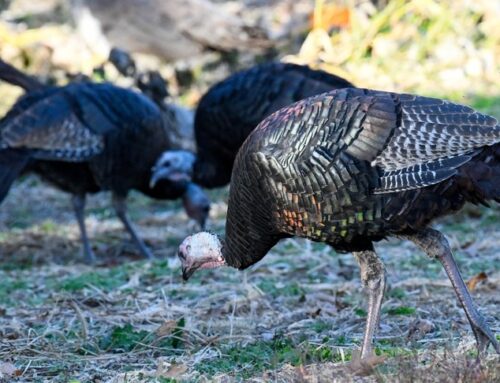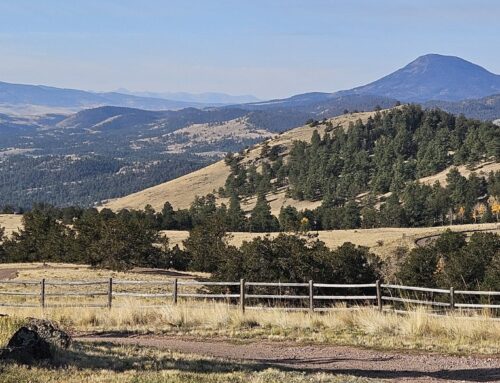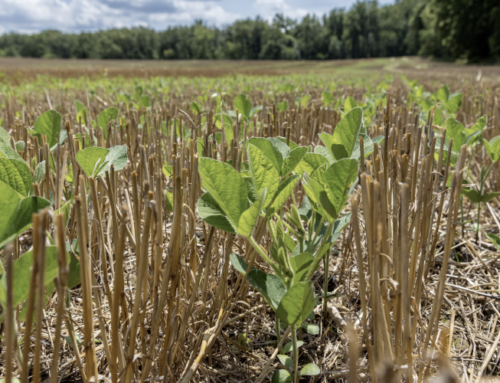A Message from Caroline Wade, STAR Executive Director
October 2023: Welcome to the first edition of the STAR Monthly Newsletter!
The national STAR organization officially launched on September 19th and was established to expand the STAR framework for conservation practice evaluation, implementation, and valuation across the country and to connect state-level STAR Affiliates.
STAR was originally founded by two farmers who believed that conservation progress required a straightforward, grassroots, and locally-led process that would make sense to farmers and resonate with stakeholders by tapping into local science and expertise to address local resources concerns. STAR has continued to develop and expand by building on this foundation and the belief that harnessing the knowledge from decades of conservation learning, experimentation, and implementation will put us on a path to conservation at scale. A belief that we need to return to the basics of conservation instead of rebranding it as “regenerative” and spending all our time and energy redefining it, once again. A new name is not going to make it easier, or cheaper.
We generally know which conservation practices work best and where. STAR believes that we need to just accept the fact that progress will require difficult, tedious, unglamorous work. Conservation has never been flashy. And it isn’t rocket science, no matter how much the start-up tech companies wish it was, so they can rescue us with expensive “solutions”. Conservation progress is the everyday story of producers mastering the art and science of making incremental changes to their complex production systems so they can increase the potential for positive environmental impacts while still keeping their books in the black. It’s the everyday work of technical service providers listening to farmers and ranchers, helping them evaluate their progress on their conservation journey, wherever they are on that journey, providing them tailored guidance, and recognizing and rewarding the risks that must be taken to improve.
The risks are real. A STAR Board member, Joe, was telling me about his soybean harvest this year and how conservation decisions made earlier this spring had impacted yields. Joe had planted cover crops last fall on two different fields and both had grown well over the winter – a significant win for building soil health and reducing water quality impacts. On one field, he burned down the cover crop before planting soybeans. On the other, he “planted green” – sowing the soybeans directly into a growing cover crop, which can prolong and increase the soil health and water quality benefits. But the weather was out of his control. A particularly wet or particularly dry spring would ultimately decide which strategy would optimize his soybean yields (which coincidentally, affects carbon sequestration and the carbon intensity of the soybeans). How should Joe be rewarded or paid for these practices? The differences in environmental outcomes are mostly driven by the weather. The models used by most market programs don’t even differentiate between the types of cover crop termination methods, some not even winter kill vs overwintering. Carbon intensity scores are heavily influenced by yield, which is heavily influenced by weather and geography. Essentially, typical “outcomes quantification” methods do not reflect his level of effort or risk or even the relative potential for environmental impacts when the weather is cooperative. In Joe’s case, the drought in Central Illinois this spring meant that the soybeans that were planted green did not do well. The cover crop competed with the seedlings for moisture, so establishment was stunted and yield suffered. A low yield is bad for business but also bad when run through market environmental outcome models. So, what is the measurement scale that puts producers first? Conservation programs should incentivize practices that have the highest potential for environmental impacts (since the actual impacts are somewhat out of a producer’s control) but should also reflect the level of effort, risk, and investment required by the producer. We cannot expect conservation adoption at scale if we ask producers to take the risk and then suffer the consequences when the weather doesn’t cooperate. Incentives should focus on helping Joe continue to innovate and take steps forward – regardless of the variability of the weather or other extenuating circumstances.
STAR does not consider outcomes quantification as the best measurement of progress, even if it is what companies think (or are told) they need, so we don’t use it. We believe conservation programs should be designed so purchasing companies are accommodating the needs of the producers being asked to make changes, not vice versa. In each state, STAR begins the process by identifying local resource concerns and goals, such as increasing water quality, soil health, or water conservation. STAR is designed to evaluate, recognize, and reward the difficult, risky, and incremental steps that are needed to maximize the potential for reducing environmental impacts while reflecting the level effort and risk undertaken by the producer. The STAR 1- 5 scale for progress evaluation is the same for a blueberry grower in Washington, a rancher in Colorado, or a corn-soybean farmer in Illinois, yet reflects the locally informed prioritization of practices and natural resource concerns of the region. The robust research- and knowledge-based process for developing field forms and practice scoring systems ensures that recommendations reflect both the best available science of a region and the practical, on-the-ground reality for producers.
To efficiently and cost effectively scale up conservation on all agricultural lands, it will take significant investment in the collective goal of optimizing locally relevant practices on as many acres as possible. Investment targeted directly to producers and technical support providers will allow us to achieve the vision of farmers and ranchers choosing conservation as the standard on all agricultural lands. A vision that aligns with their goals of agricultural economic sustainability along with clean, abundant water and healthy soils for future generations.
We can call it sustainable, regenerative, climate positive, net-zero, or carbon neutral, but it’s still just conservation. We know what to do, let’s get on with it. STAR can help lead us there – illuminating the pathway to sustained conservation. We hope you will join us on this journey!
Rocky Mountain Soil Health Roundtable Recap
Thanks to Colorado Department of Agriculture, Integrated Rocky Mountain-region Innovation Center for Healthy Soils (IN-RICHES) at CSU Spur, and Acres USA for hosting the Rocky Mountain Soil Health Roundtable in Denver on September 19th and 20th! The national STAR Team and STAR Affiliates were excited to share time with this group of passionate leaders and practitioners working toward the foundational conservation goals of soil health, water quality, and water availability. Representatives from across the Western region came together to share their experiences, identify innovative solutions and research priorities, and align on a vision for amplifying soil health efforts across the Rocky Mountain states. It was refreshing to see the focus on prioritizing the needs of farmers and ranchers to ensure they have the technical support and financial resources needed to make progress along their conservation journey and to celebrate their success. While many “industry experts” were in NYC trying to figure out the intractable problem of carbon credit accounting as part of Climate Week, these folks were identifying the real on-the-ground barriers to conservation and planning for innovative, collaborative solutions to overcome them.

STAR Landing Page Live – Full Website Coming Soon!
Saving Tomorrow’s Agriculture Resources (STAR) announced its national launch via press release on September 19, 2023. STAR will guide, inspire, and standardize state and regional STAR Affiliate organizations as they address local resource concerns and empower local farmers and ranchers to make progress on their conservation journeys – wherever they currently are. The national organization will support STAR Affiliates, expand the STAR tool, and increase conservation practices across a variety of production systems on agricultural lands. The full website will launch later this year at https://www.starconservation.org.
STAR Affiliate Updates
Spotlight on COLORADO STAR

Photo credit: Mike Peterson, Colorado farmer
Colorado STAR launched in 2022 as a partnership between the Colorado Department of Agriculture, Colorado State University (CSU), the Natural Resources Conservation Service, and other partners in Colorado. They continue to lead the way in innovative outreach strategies and communications around STAR. Partnering with the CSU’s Center for Science Communication, they are sharing stories of Colorado STAR farmers and ranchers on their soil-health journeys in a new film series called “Hold Our Ground.” The videos highlight the experiences of Colorado STAR and Colorado STAR+ farmers (Hold Our Ground: Farmers on Soil Health) and ranchers (Hold Our Ground: Ranchers on Soil Health) as they have incorporated conservation into their operations, including their challenges, successes, and learnings.
Spotlight on COLORADO STAR staff
 In July, the Colorado STAR team announced that the Colorado Department of Agriculture’s (CDA’s) own John Miller will serve as the new CDA Soil Health Program Manager. John was raised on a cattle ranch near Hotchkiss Colorado where he still lives with his wife and daughter. With a background in agriculture and engineering, John led the Delta Conservation District’s Irrigation Water Management Program for over a decade. He learned to design and troubleshoot various types of irrigation systems and gained expertise that he uses to promote efficient water usage and sustainable agricultural practices. John has worked with conservation districts across Colorado and believes that active, prosperous districts are a crucial bridge between conservation programs and local producers. Throughout his career, John has been an advocate for implementing healthy soil practices on farms and ranches. He has acquired valuable insights from producers and specialists around the state, making him well-versed in soil conservation strategies. In his most recent position as the CDA Soil Health Program Coordinator, John collaborated with the soil health team to foster partnerships, enhance program frameworks, and prepare for their much-anticipated USDA Climate Smart Commodities grant. John is enthusiastic about guiding the expansion of the Soil Health Program, ensuring it continues to offer maximum education and assistance to Colorado’s valued agriculture community.
In July, the Colorado STAR team announced that the Colorado Department of Agriculture’s (CDA’s) own John Miller will serve as the new CDA Soil Health Program Manager. John was raised on a cattle ranch near Hotchkiss Colorado where he still lives with his wife and daughter. With a background in agriculture and engineering, John led the Delta Conservation District’s Irrigation Water Management Program for over a decade. He learned to design and troubleshoot various types of irrigation systems and gained expertise that he uses to promote efficient water usage and sustainable agricultural practices. John has worked with conservation districts across Colorado and believes that active, prosperous districts are a crucial bridge between conservation programs and local producers. Throughout his career, John has been an advocate for implementing healthy soil practices on farms and ranches. He has acquired valuable insights from producers and specialists around the state, making him well-versed in soil conservation strategies. In his most recent position as the CDA Soil Health Program Coordinator, John collaborated with the soil health team to foster partnerships, enhance program frameworks, and prepare for their much-anticipated USDA Climate Smart Commodities grant. John is enthusiastic about guiding the expansion of the Soil Health Program, ensuring it continues to offer maximum education and assistance to Colorado’s valued agriculture community.
WESTERN REGION
InterMountain Soil Health Convening
STAR is working closely with The Quivira Coalition to strengthen partnerships, build synergy across programs, and explore how STAR could amplify conservation efforts across the west. The Quivira Coalition builds soil, biodiversity, and resilience on western working landscapes by fostering ecological, economic, and social health through education, innovation, and collaboration. Their work is founded on the concept that well managed working rangelands and forests are two of the most effective, efficient, and immediately viable paths to remedy the devastating impacts of climate change. The Quivira Coalition hosts a regular InterMountain Soil Health Convening to bring together conservation practitioners to share information and to cultivate hope, innovation, education, and collaboration. If you are interested in joining, please add your name to the invitation list.
Opportunities with STAR
STAR Program Manager – accepting applications
STAR is looking to hire a Program Manager, preferably with a background and network in the Western states, to join our team. Interested applicants should send a tailored cover letter describing their interest and qualifications for the role and annual compensation requirements, together with a resume and possible start date to info@STARconservation.org.
Communications Strategy and Material Development, Phase 1 RFP
STAR has issued a Request for Proposals (RFP) for Phase 1 Communications Strategy and Material Development and is looking for qualified vendors to provide communications development services that clearly communicate the messaging, branding and mission of STAR to meet the needs of a national scale program.
UPDATE: Phase II Progressive Web Application Design & Development – Request for Proposals
Thank you to those who submitted proposals for the latest RFP for the STAR Progressive Web Application Design & Development. The STAR team is scoring and evaluating applications and will be selecting a winner during the month of October.
See STAR Soon at…
National Association of Conservation Districts (NACD) Annual Meeting
The STAR team will be attending the 78th NACD Annual Meeting in San Diego, California on February 10-14, 2024. We have submitted a proposal for a breakout session with state STAR Affiliate leaders (Cindy Lair, Colorado STAR and Colorado Department of Agriculture; Michael Woods, Illinois Department of Agriculture; and Dani Gelardi, Washington State Department of Agriculture) and Amanda Raster, STAR Research & Science Director, to talk about how STAR is being used to enhance and connect state conservation programs across the US. NACD’s mission is to promote responsible management and conservation of natural resources on all lands by representing locally-led conservation districts and their associations through grassroots advocacy, education and partnerships.
News of Interest…
Saving Tomorrow’s Agriculture Resources (Julesburg Advocate – The Sedgwick County Conservation District, Colorado State University Extension, and Sedgwick County STAR (Saving Tomorrow’s Agriculture Resource) producers recently organized a brief field day at Schneider Farms. During the event, Mike Peterson shared insights into his STAR Plus Program, which focuses on cover crops in an organic system and irrigated corn. Read the whole article here.


